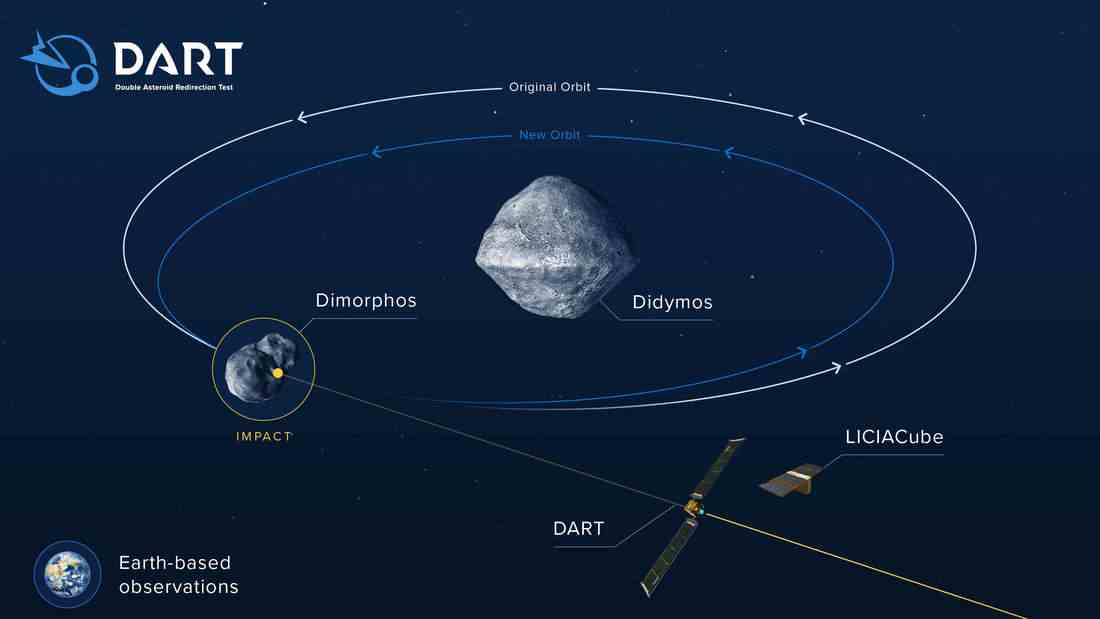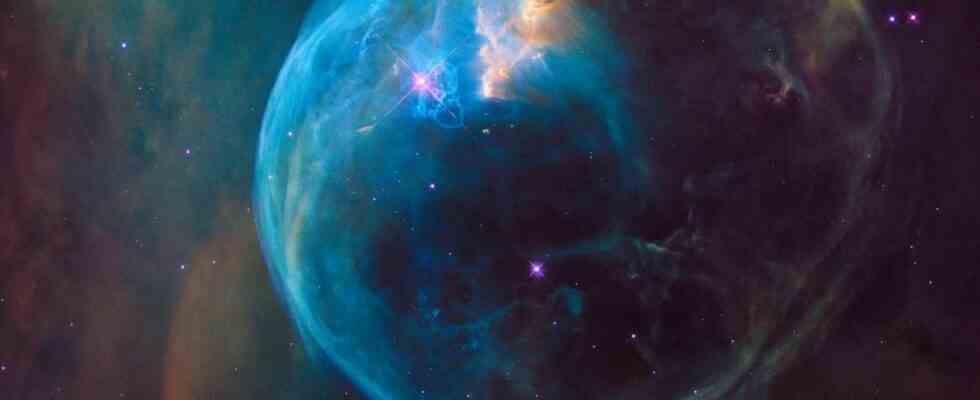What to do if an asteroid threatens the earth? Nasa wants to test a theory in practice – and push an asteroid out of its orbit.
Washington – When it comes to asteroids goes that collide with space probes in space, then it’s mostly science fiction. But in September it should become reality for the first time: Then a NASA space probe should ram an asteroid in space. The space probe “DART” (“Double Asteroid Redirection Test”) of the US space agency Nasa was already in the past year launched into space. In recent weeks, she has come closer and closer to her goal: the Didymos double asteroid system. On September 27th the NASA-Smash the spacecraft into the smaller of the two asteroids and it like that “push” out of its orbit.
“DART” is the first planetary defense mission in space history. It is envisaged that the space probe will be destroyed in the process, but its action will provide valuable data. Data that researchers on Earth can use in the event that an asteroid on a collision course with Earth is one day discovered. “These objects are racing through space and have scarred the moon and the earth has also had large impacts, that have influenced our history“Said NASA Science Director Thomas Zurbuchen at a NASA press conference. “‘DART’ is a first attempt to really get rid of a threatening object in a direct experiment,” Zurbuchen continues.
Asteroids as a danger: “Planetary Defense” wants to be prepared for emergencies
Scientists know the orbits of almost 30,000 asteroids that are in the vicinity of Earth. These asteroids are either so small that they would burn up in Earth’s atmosphere and do no harm, or they never cross Earth’s path. But that doesn’t mean there aren’t any asteroids in the solar system that could pose a threat to Earth. Planetary defense professionals want to be prepared for emergencies, which could arrive at any time. The NASA mission “DART” should contribute to this.

The asteroid system that the spacecraft is heading for consists of two asteroids: the large asteroid Didymos (diameter: about 780 meters) is orbited by the smaller asteroid Dimorphos (diameter: about 160 meters). Neither of the two asteroids poses a threat to Earth, and according to Nasa, that will not change. The “DART” space probe is intended to hit the small asteroid Dimorphos, changing its orbit minimally in the process. Currently, the smaller asteroid takes 11 hours and 55 minutes to orbit the larger asteroid. After the impact of the space probe, the orbital period should be about ten minutes less.
| Surname: | Double Asteroid Redirection Test (DART) |
| Begin: | November 24, 2021 on a SpaceX Falcon 9 rocket |
| Impact: | September 27, 2022, 1:14 am (CEST) |
| Weight at impact: | 550kg |
| Size: | 1.0 meter x 1.3 meter x 1.3 meter |
Nasa mission is observed and documented by the Italian “LICIACube”.
The small Italian CubeSat “LICIACube” from the Italian space agency ASI is to observe the impact at close range. This was launched into space together with the “DART” space probe and was to separate from it about two weeks before the planned impact. The small Italian probe is to observe the impact site about three minutes after impact and fly over it at an altitude of 55 kilometers three days after impact. The data provided by the Italian probe should help researchers on Earth to calculate exactly how the orbit has changed and to what extent this corresponds to their predictions and models.
In this way, the researchers want to refine their knowledge of how asteroids react to impacts. “We want to know what happened to Dimorphos, but it’s more important to understand what it means to potentially apply this technology in the future,” said Nancy Chabot of Johns Hopkins University’s Applied Physics Laboratory, which is leading the mission for NASA.
What happens if NASA’s DART probe misses the asteroid?
“It’s incredibly challenging,” says Evan Smith of the DART team. The challenge: the space probe can only see the small asteroid an hour and a half before the impact and has to navigate to it autonomously with the help of cameras and carry out the impact. Nevertheless, the researchers are optimistic. “For ‘DART’ to collide with Dimorphos and not see a change in orbit, that would be extraordinarily surprising,” explains Chabot. “The momentum alone that ‘DART’ brings with it due to its weight on impact is enough to measurably change the orbit of Dimorphos.”

But what happens if the space probe misses the small asteroid? Then the mission still provides the NASA scientists with a large amount of data – because even a failure would have significance for a future asteroid defense mission. “If the spacecraft misses it, we’ll still get a lot of data. This is a test mission. That’s why we’re testing: We want to do it now rather than when you really need it,” said Andrea Riley of NASA’s Planetary Defense Coordination Office.
Space Newsletter
Interested in planetary defense and other things happening in space? Subscribe to the free space newsletter and stay up to date.
The impact of NASA’s DART space probe is scheduled for September 27, 2022 at 1:14 a.m. (CEST). Numerous ground-based telescopes will then be trained on the asteroid to record possible results directly. In 2024 the Hera spacecraft the European Space Agency Esa also set off for the Didymos asteroid system and further investigate the effects of the impact. (tab)

